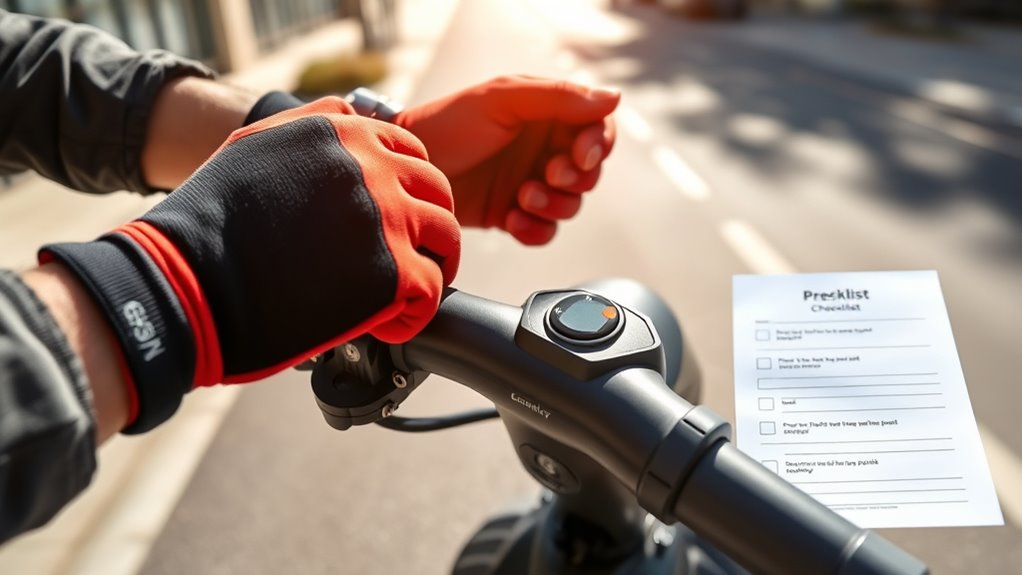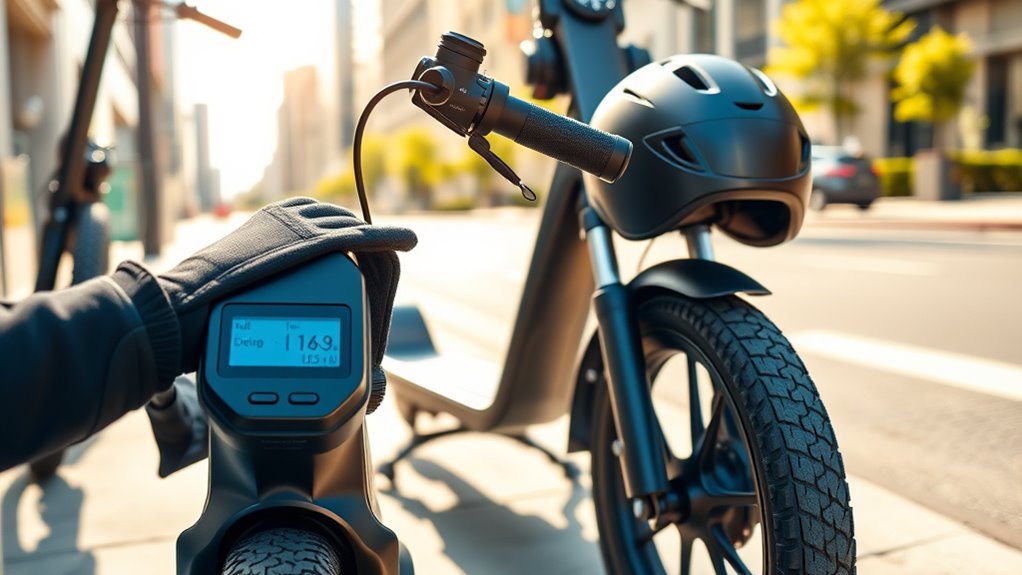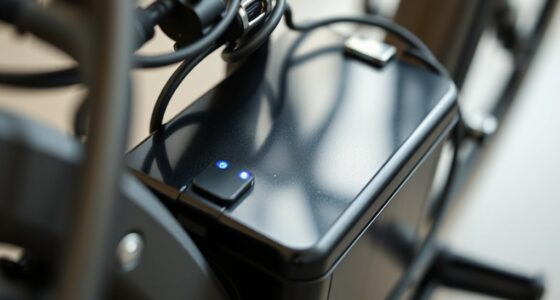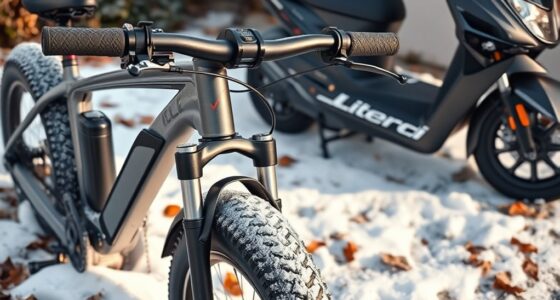Before your ride, check that your electric scooter or bike is fully charged and inspect the battery terminals for corrosion. Make certain your tires are properly inflated to the recommended PSI and look for any signs of damage. Test your brakes, lights, and reflectors to confirm they’re functioning correctly. Do a quick visual of the frame and secure all components. Maintaining these steps helps keep your ride safe and smooth—keep going to discover more essential tips.
Key Takeaways
- Check battery charge level and terminals to ensure reliable power for your ride.
- Measure tire pressure and inspect for damage or wear to ensure safety and optimal performance.
- Test brakes, lights, and reflectors for proper function and visibility.
- Perform a visual inspection of the frame and components for cracks or loose parts.
- Confirm all safety features are operational and make necessary adjustments for a smooth ride.

Before heading out on your bike, making sure to perform a pre-ride checklist is essential for safety and a smooth ride. Taking a few moments to verify key components can prevent breakdowns and ensure you’re riding comfortably. Start by inspecting the battery, especially if you’re using an electric scooter or e-bike. Battery maintenance is vital because a well-charged battery not only extends your ride time but also reduces the risk of sudden power loss. Check the battery level to guarantee it has enough charge for your planned trip. If your battery has been sitting unused for a while, consider giving it a quick charge or at least verifying that it’s holding a proper charge. Also, inspect the battery terminals for any corrosion or loose connections. Tighten or clean them if needed, as poor connections can cause power issues during your ride. Proper battery maintenance helps keep your ride reliable and prolongs the lifespan of your e-scooter or bike. Ensuring that your battery health is optimal can make a significant difference in overall performance.
Next, examine your tires, focusing on tire pressure. Properly inflated tires are essential for safety, efficiency, and comfort. Use a reliable tire pressure gauge to check the current pressure, and compare it with the manufacturer’s recommended PSI, usually printed on the sidewall of the tire. Under-inflated tires can lead to sluggish handling, increased rolling resistance, and a higher chance of flats. Over-inflated tires, on the other hand, may make your ride harsh and reduce traction. Adjust the pressure accordingly, ensuring it’s within the ideal range. Additionally, look for any signs of damage, such as cuts, embedded debris, or excessive wear, which could compromise your safety. If your tires are worn or damaged, replace them before riding. Regularly maintaining the correct tire pressure not only improves your ride quality but also extends the life of your tires and reduces the risk of unexpected flats.
Beyond the battery and tires, don’t forget to check other critical parts, like brakes, lights, and the overall condition of your frame. Confirm that brakes are responsive and pads aren’t overly worn. Ensure lights and reflectors are clean and functioning, especially if you plan to ride in low-light conditions. A quick visual inspection of the frame for cracks or damage can prevent accidents caused by structural failure. By making these checks part of your routine, you set yourself up for a safe, enjoyable ride with fewer surprises. Proper pre-ride preparation, especially focusing on battery health and tire pressure, is a small investment of time that pays off in smoother, safer journeys every time.
Frequently Asked Questions
How Often Should I Replace My Electric Scooter or Bike Batteries?
You should replace your electric scooter or bike batteries when they no longer hold a good charge or show significant performance drops. Regular battery maintenance and monitoring charging frequency help extend their lifespan. Typically, batteries last 300-500 charge cycles, so keep an eye on their performance. When you notice decreased range or longer charging times, it’s time to think about replacing the battery to make sure your ride remains reliable and safe.
Can I Ride My Electric Scooter or Bike in the Rain?
Riding your electric scooter or bike in the rain is like sailing through a storm—exciting but risky. You can go for it if you have rainproof accessories and follow waterproof riding tips, like avoiding puddles and keeping connections dry. Always check if your vehicle is rated for wet conditions. Wearing waterproof gear and using rainproof covers helps you stay safe and dry, turning a rainy day into an adventurous ride.
What Safety Gear Is Recommended for Electric Scooter and Bike Rides?
When you ride your electric scooter or bike, you should always wear helmet safety gear to protect your head in case of falls. Additionally, don’t forget to wear reflective gear, especially if you’re riding in low-light conditions, so others can see you clearly. These safety measures help prevent injuries and keep you safe on the road. Always prioritize safety gear to enjoy worry-free rides.
How Do I Troubleshoot Common Electrical Issues?
When troubleshooting common electrical issues, start with battery diagnostics to check for proper charge and performance. Next, perform a wiring inspection to look for loose connections, frayed wires, or corrosion. Make sure all connectors are secure and undamaged. If problems persist, reset the system or consult your manual. Regular maintenance helps prevent issues, so keep an eye on these components to keep your ride smooth and safe.
What Is the Maximum Recommended Weight Limit?
You might think the maximum weight limit is just a number, but it’s actually essential for safety and performance. Most electric scooters and bikes specify a load limit, typically around 220-265 pounds. Exceeding this weight capacity can strain components, reduce stability, and cause damage. Always check the manufacturer’s recommended weight capacity to guarantee safe riding and maintain the longevity of your vehicle.
Conclusion
So, after ticking off your pre-ride checklist, you’re all set to conquer the streets—armed with nothing but a fully charged battery and a helmet. Remember, a quick glance at your tires and brakes is almost as vital as remembering your phone. Because nothing says “smart commuter” like zooming off into the sunset, blissfully unaware of that tiny, ticking time bomb called your neglected safety checks. Ride smart, or prepare for an unplanned adventure—possibly involving a tumble and a dramatic fall.








